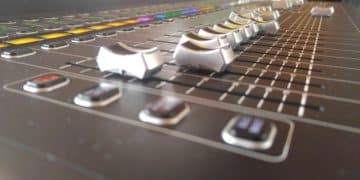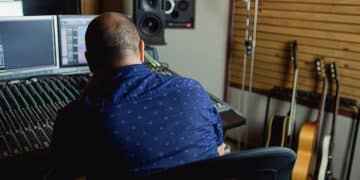Mastering EQ: Shape Your Sound with Clarity and Precision
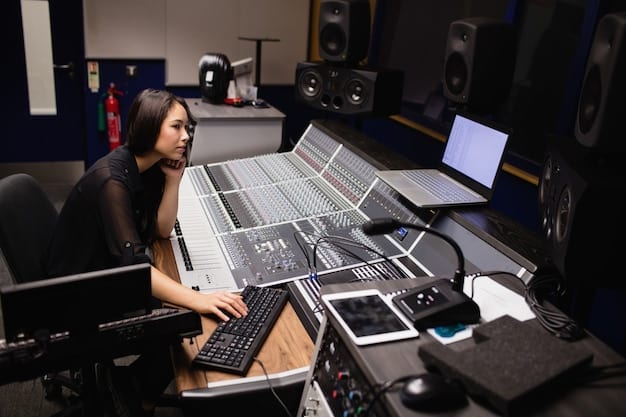
Mastering EQ involves understanding how to manipulate frequencies to shape your sound, enhance clarity, and achieve a professional-sounding mix by carefully cutting and boosting different frequency ranges, enabling a balanced and polished final product.
Have you ever felt like your music lacks that professional polish? One of the most critical skills in music production to enhance clarity and precision is mastering EQ. It’s not just about turning knobs; it’s about shaping your sound with intention and expertise.
Understanding EQ: The Basics
Equalization (EQ) is the process of adjusting the frequency content of a signal to alter its timbre. Think of it as the sculptor’s chisel for sound, allowing you to carve away unwanted frequencies and enhance the appealing ones. Knowing the basics positions you to make informed decisions about your sound.
What is Frequency?
Frequency, measured in Hertz (Hz), determines the pitch of a sound. Low frequencies correspond to bass tones, while high frequencies represent treble. Understanding the frequency spectrum is crucial in mastering EQ.
Types of EQ
There are several types of EQs, including:
- Parametric EQ: Offers precise control over frequency, gain, and bandwidth (Q).
- Graphic EQ: Divides the frequency spectrum into fixed bands, each with its own gain control.
- Shelving EQ: Boosts or cuts frequencies above or below a specified point.
- Notch Filter: Narrowly cuts a specific frequency to remove unwanted tones.
EQ is the cornerstone of any mix, providing the capabilities that helps to improve the overall sound. Familiarizing yourself with these fundamentals is the backbone to successfully mastering sound balance.
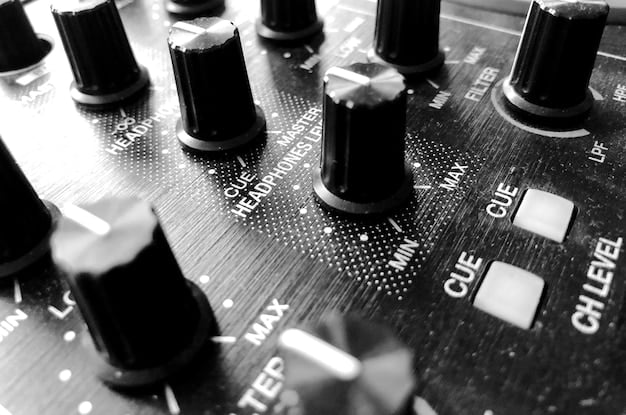
Identifying Problem Frequencies
Before you start boosting and cutting, it’s essential to identify any problem frequencies in your mix. This involves listening critically and using EQ to address issues such as muddiness, harshness, or unwanted resonances. Addressing issues early is key to a clean, transparent mix.
Sweeping Technique
One effective technique is sweeping. Create a narrow boost (high Q) with a parametric EQ and slowly sweep it across the frequency spectrum. Listen for any frequencies that sound particularly harsh or unpleasant. Once you’ve identified them, try cutting them gently.
Listen in Context
Always listen to your mix in context. A frequency that sounds problematic in isolation might be perfectly fine when other instruments are playing. Context provides the basis for well-rounded decisions, ensuring a balanced and natural-sounding mix.
Common Problem Areas
- Low-end Mud (100-300 Hz): Can make your mix sound boomy and undefined.
- Harshness (2-4 kHz): Can cause listener fatigue and make your mix sound abrasive.
- Sibilance (5-8 kHz): Excessive “s” sounds in vocals.
Problem areas are a common roadblock in mastering EQ, so knowing how to identify and address these frequencies ensures a clean master.
EQ as a Creative Tool
EQ isn’t just for fixing problems; it can also be a powerful creative tool. Use EQ to sculpt the timbre of individual instruments, create unique textures, and add depth and dimension to your mix. Unleashing the creative capabilities of EQ will give your work a unique sonic fingerprint.
Enhancing Instruments
Try boosting certain frequencies to bring out the character of an instrument. For example, a slight boost in the high frequencies (8-12 kHz) can add air and sparkle to vocals or acoustic guitars. Similarly, lifting around 250Hz-500Hz on a snare drum can often add body and punch.
Creating Space
EQ can also be used to create space in your mix. By carving out frequencies in one instrument, you can make room for another. This is especially useful in the midrange (300 Hz – 2 kHz), where many instruments compete for attention. You can cut frequencies on a pad to leave room for a vocal, or vice versa.
Coloration EQs
Experiment with different EQ plugins that offer unique sonic characteristics. Some EQs are designed to impart a certain color or character to the sound, adding warmth, saturation, or other desirable effects. Many vintage-model EQs, for example, will add pleasant harmonic distortion at higher gain settings.
Advanced EQ Techniques
Once you have a solid grasp of the basics, you can start exploring more advanced EQ techniques. These techniques can help you achieve a polished, professional-sounding mix that stands out from the crowd. Advanced techniques allow you to have more control over the dynamics and emotion of the mix.
Dynamic EQ
Dynamic EQ combines the precise control of parametric EQ with the dynamic response of a compressor. It allows you to EQ a signal based on its amplitude, addressing problems that only occur at certain levels. For example, you can use dynamic EQ to tame harshness in a vocal that only appears during loud passages.
Mid-Side (M/S) EQ
M/S EQ allows you to EQ the mid (center) and side (stereo) channels of your mix separately. This can be useful for widening the stereo image, cleaning up the center channel, or adding clarity to specific elements. You can EQ the sides brighter to give the mix more width, or tame the low end on the sides to tighten up the bass.
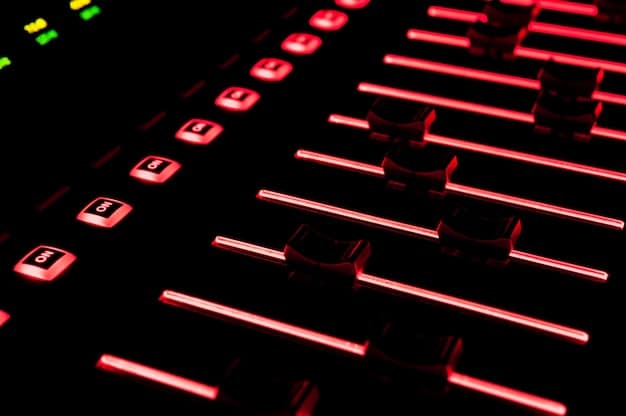
Linear Phase EQ
Linear Phase EQ preserves the phase relationship of the audio signal, minimizing phase distortion. This can be useful for mastering and other critical applications where preserving the integrity of the audio is paramount. However, linear phase EQs can introduce latency, so they are not always suitable for real-time mixing.
Linear phase helps to maintain the clarity and transient response of the audio, making it sound more natural and transparent in the end result.
Mixing vs. Mastering EQ
While both mixing and mastering involve equalization, it’s essential to understand the distinction between them. Mixing EQ is used to shape the sound of individual tracks and create a cohesive mix, while mastering EQ involves making subtle adjustments to the overall sound of the entire mix. Mixing focuses on individual elements, while mastering focuses on the overall impact.
Mixing EQ
During mixing, you have the freedom to make more drastic EQ changes to individual tracks. You can use EQ to remove unwanted frequencies, enhance the sonic characteristics of each instruments, and create space for other elements in the mix. Focus on sculpting each sound to fit well within the overall arrangement.
Mastering EQ
During mastering, your EQ moves should be far more subtle. The goal is to enhance the overall clarity, balance, and loudness of the mix without altering its fundamental character. Use gentle, broad strokes to make small improvements to the overall tonal balance. It would be a red flag if you have to correct the mixing work with EQ in the mastering stage, because there might be bigger issues to tackle first.
Collaboration
Ideally, the mixing engineer and mastering engineer should work together to ensure that the mix is properly prepared for mastering. Communication and collaboration are key to achieving the best possible results. Working together ensures the creative intent is preserved throughout the entire process.
Practical Tips for Mastering EQ
Here are some practical tips to help you master EQ:
- Use High-Quality Headphones or Studio Monitors: Accurate monitoring is essential for making informed EQ decisions. Invest in a good pair of headphones or studio monitors that provide a flat, neutral response. This will help you hear the subtle nuances in your mix and make accurate EQ adjustments.
- Trust Your Ears: While it’s helpful to understand the technical aspects of EQ, always trust your ears. If something sounds good, it probably is. Don’t be afraid to experiment and break the rules.
- Take Breaks: Listening fatigue can quickly cloud your judgment. Take frequent breaks to rest your ears and come back to your mix with a fresh perspective. This will help you make more objective EQ decisions.
- Use Reference Tracks: Comparing your mix to professionally mastered tracks in the same genre can help you identify areas where your EQ may be lacking. Use reference tracks as a guide, but don’t try to copy them exactly; strive to create your own unique sound.
Mastering EQ is a skill that takes time and practice to develop. Don’t be discouraged if you don’t get it right away. Keep experimenting, keep learning, and most importantly, keep listening.
| Key Point | Brief Description |
|---|---|
| 🎧 EQ Basics | Understanding frequency and different types of EQs. |
| 🔍 Identifying Problems | Using sweeping techniques to find harsh frequencies. |
| 🎨 Creative EQ | Enhancing instruments and creating space in the mix. |
| 🚀 Advanced Techniques | Using dynamic and M/S EQ for polished sound. |
FAQ
▼
The primary purpose of EQ is to shape the tonal balance of audio by adjusting the amplitude of different frequencies. It helps in enhancing clarity, fixing problematic frequencies, and creating space for individual instruments.
▼
Common frequency ranges include the low-end (20-250 Hz) for bass and kick drums, the midrange (250 Hz-4 kHz) for vocals and instruments, and the high-end (4 kHz-20 kHz) for air and clarity. Understanding these ranges helps in EQ decisions.
▼
To address muddiness, focus on the 200-500 Hz range. Use a narrow cut with a parametric EQ and sweep through this range to identify frequencies that sound unclear. Then, gently attenuate those frequencies.
▼
Shelving EQ boosts or cuts frequencies above or below a set point, affecting a broad range. Peaking EQ boosts or cuts around a specific center frequency, useful for targeted adjustments and problem-solving.
▼
Reference tracks are best used periodically to ensure your mix aligns with professional standards. Use them at the beginning, during critical points, and at the end to compare and make informed adjustments.
Conclusion
Mastering EQ is a journey that combines technical knowledge with artistic sensibility. Remember to trust your ears, experiment with different techniques, and always strive to create a sound that resonates with you. With practice, you’ll be amazed at how EQ can transform your music.


